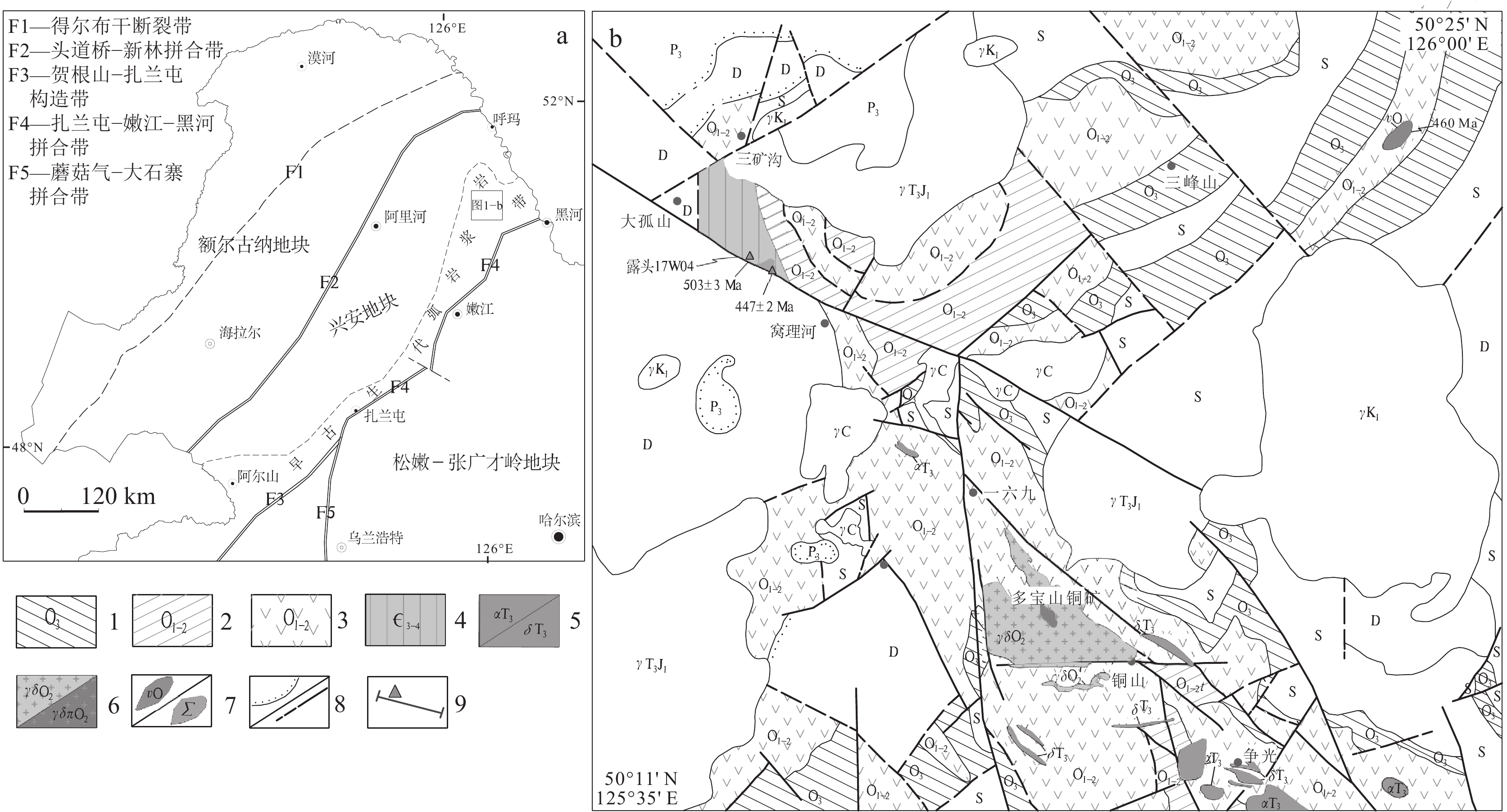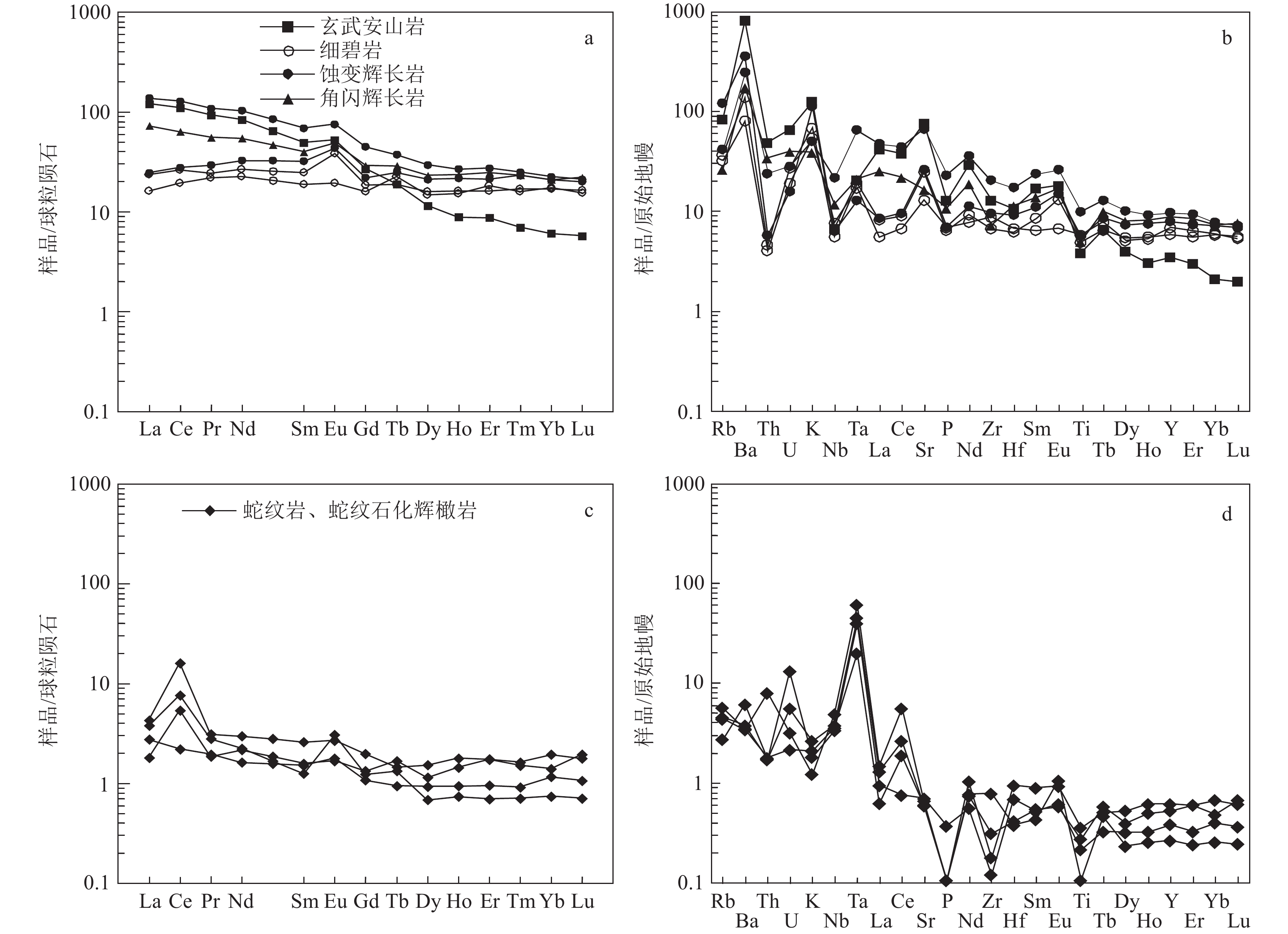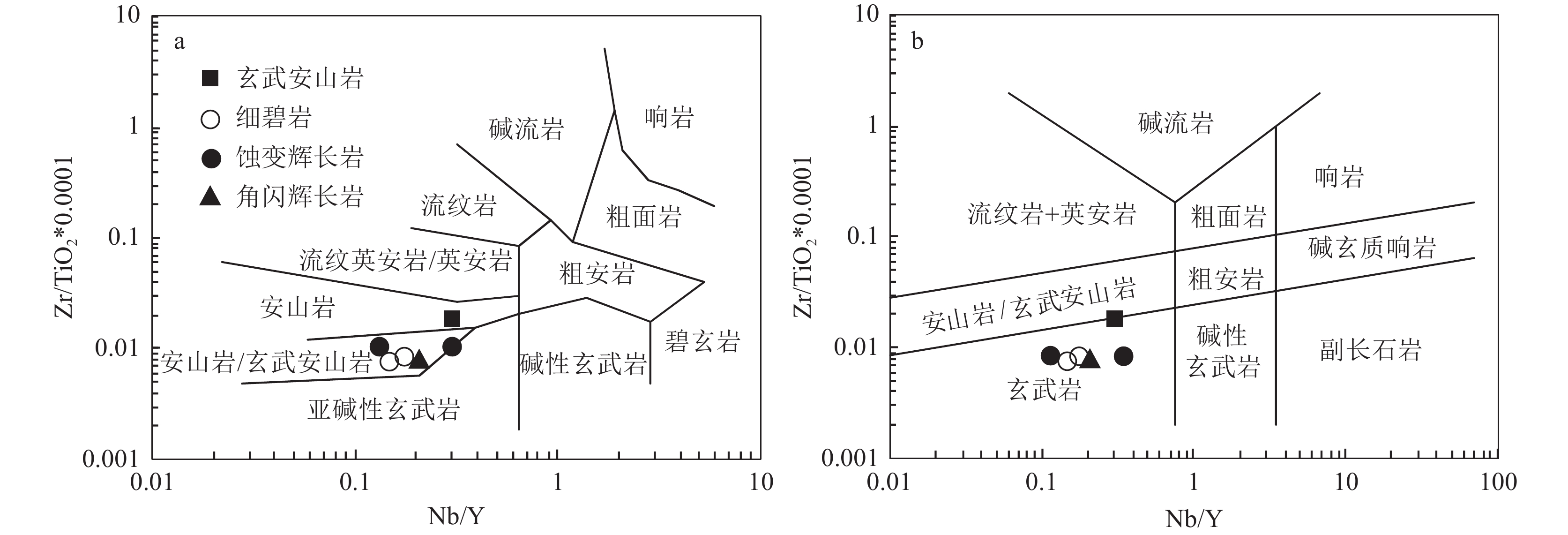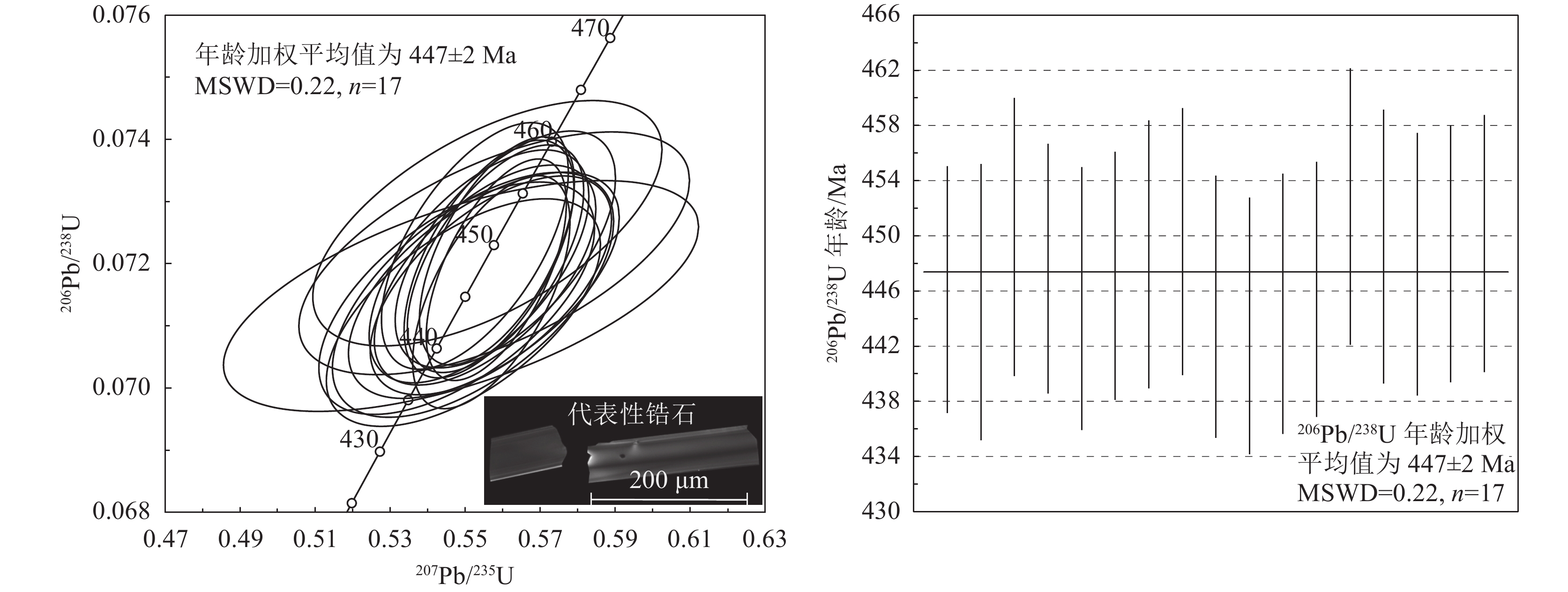Identification and tectonic setting of Early Paleozoic ophiolite in Wolihe, northern part of Greater Khingan Mountains
-
摘要:
大兴安岭北段多宝山地区窝里河一带早古生代火山-沉积地层中出露一套镁铁—超镁铁质岩,其形成时代、构造性质一直不清楚。采用岩石学、岩石地球化学及锆石U−Pb(LA−MC−ICP−MS)年代学方法对其进行了系统研究。研究表明,这套镁铁—超镁铁质岩包括蛇纹岩、蛇纹石化辉橄岩、蚀变辉长岩、角闪辉长岩、玄武安山岩及枕状玄武岩,具有蛇绿岩组合特点;前二者为地幔岩,辉长岩具堆晶岩特点,玄武安山岩相当于基性岩墙,枕状玄武岩为海底喷出岩;它们都呈岩块状分布在早古生代片理化火山碎屑岩-碎屑沉积岩基质中,共同构成一套蛇绿混杂岩。其中,镁铁质岩石属于钙碱性系列,超镁铁岩与镁铁质岩石均富集大离子亲石元素Ba、K、Sr,亏损高场强元素Nb、P、Ti及Th,具有活动大陆边缘弧火山岩特点;获得蛇绿岩上部单元玄武安山岩形成时代447 Ma。总括蛇绿岩岩石组合及地球化特征,认为蛇绿岩属消减型蛇绿岩(SSZ),形成于弧背盆地构造背景;蛇绿岩构造侵位最年轻地质体为早—中奥陶世,推测蛇绿岩构造侵位于晚奥陶世末期。
Abstract:A set of mafic−ultramafic rocks emerged from the Early Paleozoic volcano−sedimentary strata in the Wolihe of Duobaoshan area, northern part of the Greater Khingan Mountains, whose formation age and structural properties are still unclear.In this paper, petrology, petrogeochemistry and zircon U−Pb (LA−MC−ICP−MS) chronology are used to systematically study the set of mafic−ultramafic rocks.The results show that the mafic−ultramafic rocks include serpentinite, serpentinized pyroxene peridotite, altered gabbro, hornblende gabbro, basaltic andesite and pillow basalt, which have the characteristics of ophiolite combination; The first two are mantle rocks, gabbro has the characteristics of cumulates, basalt andesite is equivalent to basic dike, pillow basalt is submarine extruded rock; They are distributed in the matrix of Early Paleozoic stratified pyroclastic rock and clastic sedimentary rock, and together constitute a set of ophiolitic mellitic rocks.Among them, mafic rocks belong to the calc−alkaline series,ultramafic rocks and mafic rocks are rich in large ion lithophile elements Ba, K, Sr, and depleted in high field strength elements Nb, P, Ti and Th, which have the characteristics of active continental margin arc volcanic rocks.The formation age of basalt andesite in the upper unit of ophiolite is 447 Ma.In summary, it is considered that the ophiolite belongs to suprasubduction zone type ophiolite (SSZ), which formed in the tectonic setting of the arc back basin. The youngest geological body of the ophiolite tectonic emplacement is the Early to Middle Ordovician, and it is speculated that the ophiolite tectonic emplacement is located at the end of the late Ordovician, it is inferred that the ophiolite tectonic emplacement was at the end of the Late Ordovician.
-
-
图 1 黑龙江多宝山地区大地构造位置(a)和地质简图(b,据黑龙江省地质调查研究院,2009修改)
P3—上二叠统;D—泥盆系;S—志留系;γK1—早白垩世花岗岩;γT3J1—晚三叠世-早侏罗世花岗岩;γC—早石炭世花岗岩;1—上奥陶统;2—早-中奥陶世碎屑沉积建造;3—早-中奥陶世火山建造;4—寒武系苗岭统-芙蓉统;5—晚三叠世潜安山岩及闪长岩;6—中奥陶世花岗闪长岩及花岗闪长斑岩;7—晚奥陶世辉长岩/超镁铁岩;8—不整合界线/断层;9—样品及露头位置
Figure 1. Tectonic location map (a) and geological sketch map (b) of Duobaoshan area, Heilongjiang Province
图 3 蛇绿岩堆积岩判别图(据Coleman,1982)( TFeO为全部铁换算成FeO)
Figure 3. Discriminant map of ophiolite accumulations
表 1 样品主量、微量和稀土元素分析结果
Table 1 Major, trace elements and REE values for the sample
元素 b17 b6 b7 b11 b15 b8 b9 b18 b10 b14 玄武安山岩(岩块) 蛇纹岩(蛇纹石化辉橄岩) 蚀变辉长岩(岩块) 角闪辉长岩(岩块) 细碧岩(岩块) SiO2 52.61 38.89 38.45 38.70 39.30 42.47 35.71 49.96 47.61 45.02 Al2O3 15.61 1.16 1.15 0.82 0.18 17.52 20.56 15.75 16.65 16.60 Fe2O3 0.71 4.60 4.12 4.82 4.09 1.24 5.11 1.61 1.88 1.94 MgO 7.09 38.39 38.92 38.71 39.15 8.76 8.64 8.03 6.53 9.30 MnO 0.22 0.16 0.17 0.16 0.20 0.24 0.17 0.20 0.27 0.23 TiO2 0.80 0.07 0.05 0.04 0.02 1.18 2.03 1.03 1.01 1.19 CaO 5.66 0.03 0.01 0.13 0.08 10.74 14.45 4.60 6.04 4.21 K2O 3.59 0.03 0.05 0.05 0.07 3.24 1.43 1.12 1.96 1.55 Na2O 4.18 0.06 0.01 0.04 0.07 1.06 0.06 5.00 3.64 3.93 P2O5 0.27 0.00 0.00 0.01 0.00 0.15 0.47 0.22 0.13 0.14 FeO 5.30 3.95 4.04 2.97 3.23 9.88 6.29 8.49 9.88 11.55 烧失量 3.40 12.67 12.71 13.21 13.47 2.93 4.99 3.77 4.21 4.67 总计 99.42 100.02 99.67 99.65 99.86 99.39 99.92 99.77 99.81 100.32 TFeO 5.94 8.08 7.74 7.31 6.91 10.99 10.89 9.93 11.57 13.29 Mg# 68.01 89.43 89.96 90.42 90.99 58.67 58.58 59.03 50.15 55.50 σ 2.50 - - - - - - 2.32 2.61 3.85 Y 15.79 2.80 2.38 1.73 1.21 35.62 43.94 39.70 26.54 30.96 La 28.60 1.02 0.43 0.65 0.89 5.80 32.44 17.22 5.58 3.79 Ce 67.18 9.84 3.30 1.34 4.66 16.99 78.14 38.68 15.96 11.85 Pr 8.82 0.29 0.18 0.19 0.26 2.77 10.25 5.27 2.29 2.08 Nd 39.14 1.39 1.01 0.75 1.04 15.10 48.09 25.31 12.44 10.48 Sm 7.50 0.40 0.24 0.23 0.19 4.89 10.52 6.09 3.74 2.85 Eu 3.04 0.16 0.10 0.10 0.18 2.50 4.38 2.84 2.20 1.12 Gd 5.50 0.41 0.27 0.22 0.25 4.50 9.18 5.97 3.77 3.28 Tb 0.71 0.05 0.06 0.04 0.05 0.92 1.39 1.07 0.70 0.84 Dy 2.91 0.39 0.29 0.24 0.17 5.37 7.46 5.87 4.00 3.74 Ho 0.50 0.10 0.08 0.05 0.04 1.22 1.51 1.32 0.91 0.86 Er 1.43 0.29 0.29 0.16 0.12 3.52 4.50 4.08 2.65 3.03 Tm 0.18 0.04 0.04 0.02 0.02 0.59 0.63 0.59 0.43 0.40 Yb 1.03 0.33 0.24 0.20 0.13 3.54 3.81 3.57 2.85 2.93 Lu 0.15 0.05 0.05 0.03 0.02 0.51 0.53 0.56 0.41 0.39 Sr 1600.00 13.86 12.52 14.81 12.61 550.95 1400.00 345.64 519.08 271.03 Ba 5600.00 23.66 24.17 42.69 26.39 2500.00 1700.00 1200.00 950.02 556.64 Cr 27.76 3100.00 3100.00 3400.00 2700.00 204.63 158.37 181.27 35.67 60.03 Co 36.28 166.98 174.42 157.20 178.64 56.60 72.74 75.76 31.24 46.91 Ni 18.76 2400.00 2200.00 2300.00 2000.00 84.17 145.13 67.90 22.13 48.47 V 99.01 28.68 25.61 32.06 23.52 256.91 199.58 200.20 292.01 298.36 Nb 4.80 3.48 2.55 2.38 2.69 4.49 15.37 8.35 3.97 5.46 Ta 0.83 2.46 0.81 1.61 1.83 0.52 2.67 0.86 0.78 0.70 Rb 52.77 2.76 3.57 1.73 2.87 76.16 26.21 16.56 23.33 20.25 Li 104.23 30.19 26.31 11.54 17.60 128.15 230.13 93.95 227.24 153.04 Be 1.73 0.12 0.12 0.21 0.13 0.52 1.06 0.93 0.38 0.49 Zr 143.72 2.00 3.50 1.35 8.82 107.05 227.86 81.24 74.53 97.28 Hf 3.27 0.29 0.13 0.21 0.12 2.81 5.33 3.48 1.91 2.07 Th 4.11 0.68 0.15 0.15 0.15 0.49 2.03 2.89 0.39 0.34 U 1.37 0.07 0.05 0.27 0.12 0.33 0.59 0.83 0.57 0.40 Sc 4.94 7.02 6.70 5.49 5.00 28.03 18.13 21.30 16.20 21.04 Eu* 1.38 1.18 1.15 1.39 2.47 1.60 1.33 1.42 1.78 1.12 Ce* 1.03 4.36 2.95 0.93 2.32 1.03 1.04 0.99 1.09 1.02 ΣREE 166.68 14.74 6.57 4.22 8.02 68.22 212.83 118.44 57.93 47.65 (La/Yb)N 19.93 2.21 1.29 2.38 5.09 1.18 6.11 3.46 1.41 0.93 (Gd/Yb)N 4.42 1.02 0.95 0.93 1.65 1.05 2.00 1.38 1.09 0.93 La/Ta 34.32 0.41 0.53 0.40 0.49 11.11 12.15 20.14 7.18 5.42 MgO/SiO2 0.13 0.99 1.01 1.00 1.00 0.21 0.24 0.16 0.14 0.21 MgO/(MgO+TFeO) 0.54 0.83 0.83 0.84 0.85 0.44 0.44 0.45 0.36 0.41 Ti/V 48.31 14.00 12.06 7.48 5.10 27.46 60.94 30.96 20.75 23.98 Nb/Y 0.30 1.24 1.07 1.37 2.23 0.13 0.35 0.21 0.15 0.18 注:主量元素含量单位为%,微量和稀土元素含量单位为10−6。Eu∗=EuN/√SmN×GdN,Ce∗=CeN/√LaN×PrN 表 2 玄武安山岩LA−MC−ICP−MS锆石U−Th−Pb测试结果
Table 2 LA−MC−ICP−MS zircon U−Th−Pb dating results for the basaltic andesite
测点 含量/10−6 Th/U 普通铅校正后同位素比值 普通铅校正后年龄/Ma Pb U Th 206Pb/238U ±1σ 207Pb/235U ±1σ 207Pb/206Pb ±1σ 206Pb/238U ±1σ 207Pb/235U ±1σ 207Pb/206Pb ±1σ 1 12 143 174 1.22 0.0717 0.0007 0.5569 0.0131 0.0564 0.0013 446 4 449 11 467 50 2 19 212 267 1.26 0.0715 0.0008 0.5521 0.0153 0.0560 0.0013 445 5 446 12 452 51 3 8 74 90 1.21 0.0747 0.0009 1.1926 0.0513 0.1158 0.0047 465 6 797 34 1892 73 4 19 234 201 0.86 0.0723 0.0008 0.5526 0.0102 0.0554 0.0009 450 5 447 8 430 35 5 79 891 1162 1.30 0.0719 0.0007 0.5583 0.0076 0.0563 0.0007 448 5 450 6 465 28 6 32 380 352 0.93 0.0715 0.0008 0.5570 0.0086 0.0565 0.0008 445 5 450 7 471 31 7 16 185 233 1.26 0.0718 0.0007 0.5553 0.0121 0.0561 0.0011 447 4 448 10 455 45 8 27 325 307 0.94 0.0721 0.0008 0.5563 0.0092 0.0560 0.0008 449 5 449 7 452 33 9 14 163 174 1.06 0.0722 0.0008 0.5607 0.0120 0.0563 0.0011 450 5 452 10 464 44 10 15 177 170 0.96 0.0714 0.0008 0.5477 0.0150 0.0556 0.0013 445 5 444 12 436 53 11 21 236 240 1.02 0.0712 0.0007 0.5495 0.0149 0.0560 0.0013 443 5 445 12 451 52 12 12 141 159 1.13 0.0715 0.0008 0.5489 0.0259 0.0557 0.0026 445 5 444 21 440 104 13 12 139 154 1.11 0.0717 0.0007 0.5550 0.0147 0.0562 0.0015 446 5 448 12 459 61 14 12 140 135 0.96 0.0727 0.0008 0.5559 0.0190 0.0555 0.0018 452 5 449 15 432 72 15 8 107 31 0.29 0.0722 0.0008 0.5577 0.0213 0.0561 0.0019 449 5 450 17 454 77 16 13 155 157 1.01 0.0720 0.0008 0.5537 0.0120 0.0558 0.0011 448 5 447 10 445 45 17 21 254 233 0.92 0.0721 0.0007 0.5581 0.0096 0.0562 0.0009 449 5 450 8 458 36 18 45 523 580 1.11 0.0722 0.0007 0.5584 0.0084 0.0561 0.0008 449 5 451 7 456 30 -
Bao Z W, Chen S H, Zhang Z T. 1994. Study on REE and Sm−Nd isotopes of Hegenshan Ophiolite, Inner Mongolia[J]. Geochimica, 23(4): 340−349(in Chinese with English abstract).
Coleman R G. Translated by Bao P S. 1982. Ophiolite [M]. Beijing: Geological Publishing House: 29−64/ (in Chinese).
Condie K C. 1976. Plate tectonics and crustal evolution[M]. London: Pergamon Press: 1−288.
Cui G, Wang J Y, Zhang J X, et al. 2008. U−Pb SHRIMP dating of zircons from Duobaoshan granodiorite in Heilongjiang and its geological significance[J]. Global Geology, 27(4): 386−394(in Chinese with English abstract).
Deng J H, Luo Z H, Shu S G, et al. 2004. Petrogenesis, tectonic environment and mineralization[M]. Beijing: Geological Publishing House: 11−21(in Chinese).
Dilek Y. 2003. Ophiolite concept and its evolution[J]. Geological Society of America, Special Paper, 373: 1−16.
Dilek Y, Furnes H, Shallo M. 2007. Suprasubduction zone ophiolite formation along the periphery of Mesozoic Gondwana[J]. Gondwana Research, 11: 453−475. doi: 10.1016/j.gr.2007.01.005
Dilek Y, Furnes H. 2011. Ophiolite genesis and global tectonics: Geochemicaland tectonic fingerprinting of ancient oceanic lithosphere[J]. Geological Society of America Bulletin, 123: 387−411. doi: 10.1130/B30446.1
Du B Y, Feng Z Q, Liu Y W, et al. 2017. Determination of Neoproterozoic meta−gabbro from Huanerku, Da Hinggan mountains and its geological significance[J]. Global Geology, 36(3): 751−762(in Chinese with English abstract).
Feng Z Q, Liu Y J, Li Y R, et al. 2017. Ages, geochemistry and tectonic implications of the Cambrian igneous rocks in the northern Great Xing'an Range, NE China[J]. Journal of Asian Earth Sciences, 144: 5−21. doi: 10.1016/j.jseaes.2016.12.006
Feng Z Q, LiuY J, Jin W, et al. 2019. Spatiotemporal distribution of ophiolites in the northern Great Xingan Range and its relationship with the geotectonic evolution of NE China[J]. Earth Science Frontiers, 26(2): 120−136(in Chinese with English abstract).
Fu J Y, Wang Y, Na F C, et al. 2015. Zircon U−Pb geochronology and geochemistry of the Hadayang mafic−ultramafic rocks in Inner Mongolia: Constraints on the Late Devonian subduction of Nenjiang−Heihe area, Northeast China[J]. Geology in China, 42(6): 1740−1753(in Chinese with English abstract).
Fu J Y, Zhu Q, Yang Y J, et al. 2019. Geological Map of the People's Republic of China (Northeast) (1∶1 500 000)[M]. Beijing: Geology Press: 105−143(in Chinese).
Fu J Y, Na F C, Qiang C, et al. 2023. Chronology and tectonic setting of the Luomahu rock group in the Woduhe area, northwest of Lesser Hinggan mountains[J]. Geology and Resources, 32(1): 1−13 (in Chinese with English abstract).
Ge W C, Wu F Y, Zhou C Y, et al. 2007. Porphyry Cu−Mo deposits in the eastern Xing'an−Mongolian Orogenic Belt: Mineralization ages and their geodynamic implications[J]. Chinese Science Bulletin, 52(24): 3416−3427. doi: 10.1007/s11434-007-0466-8
Hao Y J, Ren Y S, Duan M X, et al. 2015. Metallogenic events and tectonic setting of the Duobaoshan ore field in Heilongjiang Province, NE China[J]. Journal of Asian Earth Sciences, 97: 442−458. doi: 10.1016/j.jseaes.2014.08.007
Huang Y W, Liu Y, Wang X C, et al. 2009. Petrological features and tectonic significance of the Ordovician in Duobaoshan ore district, northern Heilongjiang[J]. Chinese Journal of Geology, 44(1): 245−256(in Chinese with English abstract).
Jian P, Kröner A, Windley B F, et al. 2010. Zircon ages of the Bayankhongor ophiolite mélange and associated rocks: Time constraints on Neoproterozoic to Cambrian accretionary and collisional orogenesis in Central Mongolia[J]. Precambrian Research, 177: 162−180. doi: 10.1016/j.precamres.2009.11.009
Jian P, Kröner A, Windley B F, et al. 2012. Carboniferous and Cretaceous mafic–ultramafic massifs in Inner Mongolia (China): A SHRIMP zircon and geochemical study of the previously presumed integral “Hegenshan ophiolite”[J]. Lithos, 142/143: 48−66. doi: 10.1016/j.lithos.2012.03.007
Li C N. 1992. Petrology of trace elements in igneous rocks[M]. Wuhan: China University of Geosciences Press: 104−118(in Chinese).
Li H K, Geng J Z, Hao S A, et al. 2009. Using laser ablation multiple receivers plasma mass spectrometer (LA−MC−ICPMS) determination of zircon U−Pb isotope age[J]. Acta Mineralogica Sinica, 29(S1): 600−601(in Chinese with English abstract).
Li H Y, Zhou Z G, Li P G, et al. 2016. Geochemical features and significance of Late Ordovician Gabbros in East Ujimqin Banner, Inner Mongolia[J]. Geological Review, 62(2): 300−316(in Chinese with English abstract).
Li Y, Xu W L, Wang F, et al. 2017. Early−Middle Ordovician volcanism along the eastern margin of the Xing’an Massif, Northeast China: Constraints on the suture location between the Xing’an and Songnen–Zhangguangcai Range massifs[J]. International Geology Review, 2017: 1−17.
Li Y. 2016. The study of the main rock and typical deposits in the North of Duobaoshan district, Heilongjiang Province[D]. Master's Thesis of China University of Geosciences(Beijing) (in Chinese with English abstract).
Lin M, Ma C Q, Xu L M, et al. 2019. Geological characteristics of subduction−accretionary complexes in Hellestein district, Inner Mongolia and its discovery significance[J]. Earth Science, 44(10): 3279−3296 (in Chinese with English abstract).
Lin M. 2022. The compositional and structural characteristics of the subduction−accretion melange belt in Hailesitai, Inner Mongolia[D]. PhD Dissertation of China University of Geosciences(Wuhan) (in Chinese with English abstract).
Liu J F, Sun W D, Sun Y, et al. 2008. Geochemistry and Platinum−group Elements of Ultramafic Rocks from the Songshugou Area in the Eastern Qinling: Constraints on Petrogenesis[J]. Geological Review, 54(1): 57−64(in Chinese with English abstract).
Liu J F, Li J Y, Zhao S, et al. 2023. A late Neoproterozoic to early Paleozoic accretionary orogenic belt in the eastern Central Asian orogenic Belt: Evidence from the Irshi ophiolite m´elange in the middle segment of the Great Xing’an Range[J]. Journal of Asian Earth Sciences, (251): 105657.
Liu J, Zhou Z H, He Z F, et al. 2015. Zircon U−Pb dating and geochemistry of ore−bearing tonalite in Tongshan copper deposit, Heilongjiang Province[J]. Mineral Deposits, 34(2): 289−308(in Chinese with English abstract).
Liu Y J, Feng Z Q, Jiang L W, et al. 2019. Ophiolite in the eastern Central Asian Orogenic Belt, NE China[J]. Acta Petrologica Sinica, 35(10): 3017−3047 (in Chinese with English abstract).
Liu Y S, Hu Z C, Gao S, et al. 2008. In situ analysis of major and trace elements of anhydrous minerals by LA−MC−ICP−MS without applying an internal standard[J]. Chemical Geology, 257: 34−43. doi: 10.1016/j.chemgeo.2008.08.004
Ludwig, K. R. 2003. ISOPLOT 3.00: A Geochronological Toolkit for Microsoft Excel[M]. Berkeley: Berkeley Geochronology Center, California.
Ma Q, Liu J F, Chi X G. 2018. Petrogeochemistry of the Late Ordovician quartzdiorite in Zhalantun area of Da Hinggan Mountains and its geological significance[J]. Geological Bulletin of China, 37(5): 853−862(in Chinese with English abstract).
Miao L C, Fan W M, Liu D Y, et al. 2008. Geochronology and geochemistry of the Hegenshan ophiolitic complex: Implications for late− stage tectonic evolution of the Inner Mongolia− Daxinganling Orogenic Belt, China[J]. Journal of Asian Earth Sciences, 32(5): 348−370.
Miao L C, Zhang F Q, Jiao S J. 2015. Age, protoliths and tectonic implications of the Toudaoqiao blueschist Inner Mongolia, China[J]. Journal of Asian Earth Sciences, 105: 360−373. doi: 10.1016/j.jseaes.2015.01.028
Na F C, Fu J Y, Wang Y, et al. 2014. LA−ICP−MS zircon U−Pb age of the chlorite−muscovite tectonic schist in Hadayang, Morin Dawa Banner, Iner Mongolia, and its tectonic significance[J]. Geological Bulletin of China, 33(9): 1326−1332(in Chinese with English abstract).
Na F C, Wu Y, Song W M, et al. 2022. Geochronology, petrogenesis, and tectonic implications of Early Paleozoic intermediate−basic complex of East Ujimqin Banner area[J]. Acta Petrologica Sinica, 38(9): 2762−2780(in Chinese with English abstract).
Pan G T, Xiao Q H, Lu S N, et al. 2009. Subdivision of tectonic units in China[J]. Geology in China, 39(1): 1−28 (in Chinese with English abstract).
Pearce J A. 1982. Trace element characteristics of lava from destructive plate boundaries[C]//Thorpe R S. Andesites: orogenic andesites and related rocks. New York: John Willey and Suns: 525−548.
Pearce J A. 2008. Geochemical fingerprinting of oceanic basalts with applications to ophiohte classification and the search for Archean oceanic crust[J]. Lithos, 100: 14−48. doi: 10.1016/j.lithos.2007.06.016
Qin T, Guo R R, ZangY Q, et al. 2019. Recognition of Early Paleozoic magmatisms in the supposed Proterozoic basements of Zhalantun, Great Xing’an Range, NE China[J]. Acta Geologica Sinica (English Edition), 93(5): 1434−1455. doi: 10.1111/1755-6724.14359
Robinson P T, Bai W J, Yang J S, et al. 1995. Geochemical constraints on petrogenesis and crustal accretion of the Hegenshan Ophiolite, Northern China[J]. Acta Petrologica Sinica, 11(Supp): 112−124(in Chinese with English abstract).
Shao X F. 2018. Geochemical characteristics and geological significance of the Ordovician Duobaoshan Formation located in Dula’er Bridge in Inner Mongolia[J]. Jilin Geology, 37(4): 21−28(in Chinese with English abstract).
Shervais J W. 1982. Ti−V plots and the petrogenesis of modern and ophiolitic lavas[J]. Earth and Planetary Science Letters, 59(1): 101−118. doi: 10.1016/0012-821X(82)90120-0
Shu G L, Li Z M, Lv J C, et al. 2019. Structural evolution and optimization of prospecting target area in Arong Banner area, east margin of Greater Khingan Mountains[M]. Wuhan: China University of Geosciences Press(in Chinese).
Wang L M. 2015. Geochemistry of the Ordovician vocanic rocks in Aershan, Inner Mongolia and its tectonic significance[D]. Master Thesis of Jilin University(in Chinese with English abstract).
Wang Y, Fu J Y, Yang F, et al. 2015. Contraction and extension in Nenjiang−Heihe tectonic belt: Evidence from the Late Paleozoic granitoid geochemistry[J]. Journal of Jilin University: Earth Science Edition, 45(2): 374−388(in Chinese with English abstract).
Wang Z G, Yu X Y, Zhao Z H, et al. 1989. Rare Earth Element Geochemistry [M]. Beijing: Science Press: 165−182(in Chinese).
Wu G, Chen Y C, Sun F Y, et al. 2015. Geochronology, geochemistry, and Sr−Nd−Hf isotopes of the early Paleozoic igneous rocks in the Duobaoshan area, NE China, and their geological significance[J]. Journal of Asian Earth Sciences, 97: 229−250. doi: 10.1016/j.jseaes.2014.07.031
Wu Y B, Zheng Y F. 2004. Zircon genetic mineralogy research and interpretation of U−Pb age restriction[J]. Chinese Science Bulletin, 49(16): 1589−1604(in Chinese with English abstract). doi: 10.1360/csb2004-49-16-1589
Xiang A P, Yang Y C, Li G T, et al. 2012. Diagenetic and metallogenic ages of Duobaoshan porphyry Cu−Mo deposit in Heilongjiang Province[J]. Mineral Deposits, 31(6): 1237−1248(in Chinese with English abstract).
Yang Y S, Lv X B, Gao R Z, et al. 2016. Geochronology, Geochemistry and Geological Significance of the Tonalite Porphyry in Zhengguang gold deposit, Heilongjiang Province[J]. Geotectonica et Metallogenia, 40(4): 674−700(in Chinese with English abstract).
Yang Z L, Wang S Q, Hu X J, et al. 2018. Geochronology and geochemistry of Early Paleozoic gabbroic diorites in East Ujimqin Banner of Inner Mongolia and their geological significance[J]. Acta Petrologica et Mineralogica, 37(3): 349−365(in Chinese with English abstract).
Yang Z L, Hu X J, Wang S Q, et al. 2020. Geochronology, geochemistry and geological significance of Early Paleozoic volcanic rocks in northern East Ujimqin Banner, Inner Mongolia[J]. Acta Petrologica Sinica, 36(4): 1107−1126(in Chinese with English abstract). doi: 10.18654/1000-0569/2020.04.09
Yu J J, Xu Z G, Xu F S. 1996. Tectonic setting of Ordovician volcanic rocks in northwestern Xiaoxinganling, Heilongjiang Province[J]. Acta Geoscientia Sinica, 17(1): 54−64 (in Chinese with English abstract).
Zeng Q D, Liu J M, Chu S X, et al. 2014. Re−Os and U−Pb geochronology of the Duobaoshan porphyry Cu−Mo−(Au)deposit, northeast China, and its geological significance[J]. Journal of Asian Earth Sciences, 79: 895−909. doi: 10.1016/j.jseaes.2013.02.007
Zhang J, Deng J F, Xiao Q H, et al. 2012. New advances in the study of ophiolites[J]. Geological Bulletin of China, 31(1): 1−12(in Chinese with English abstract).
Zhang Q. 1990. Classification of ophiolites[J]. Scientia Geologica Sinica, 25(1): 54−61.
Zhang Q, Qian Q, Wang Y. 2000. Rock Assemblages of Ophiolites and Magmatism beneath Oceanic Ridges[J]. Acta Petrologica et Mineralogica, 19(1): 1−7(in Chinese with English abstract).
Zhang Q. 2014. Classifications of mafic−ultrafic rockes and their tectonics significance[J]. Chines Journal of Geology, 49(3): 982−1017(in Chinese with English abstract).
Zhao C, Qin K Z, Song G X, et al. 2018. Petrogenesis and tectonic setting of ore−related porphyry in the Duobaoshan Cu deposit within the eastern Central Asian Orogenic Belt, Heilongjiang Province, NE China[J]. Journal of Asian Earth Sciences, 165: 352−370. doi: 10.1016/j.jseaes.2018.07.002
Zhao C, Qin K Z, Song G X, et al. 2019. Early Palaeozoic high−Mg basalt−andesite suite in the Duobaoshan Porphyry Cu deposit, NE China: Constraints on petrogenesis, mineralization, and tectonic setting[J]. Gondwana Research, 71: 91−116. doi: 10.1016/j.gr.2019.01.015
Zhao H L, Zhu C Y, Liu H Y, et al. 2012. Zircon SHRIMP U−Pb dating and its tectonic implications of the granodiorite in Duobaoshan copper deposit, Heilongjiang Province[J]. Geology and Resources, 21(5): 421−424 (in Chinese with English abstract).
Zhao Z, Chi X G, Pan S Y, et al. 2010. Zircon U−Pb LA−ICP−MS dating of Carboniferous volcanics and its geological significance in the northwestern Lesser Xing' an Range[J]. Acta Petrologica Sinica, 26(8): 2452−2464(in Chinese with English abstract).
Zhou G Q. 2008. Ophiolite: Some key aspects regarding its definition and classification[J]. Journal of Nanjing University (Natural Sciences), 44(1): 1−24(in Chinese with English abstract).
Zhou J B, Wang B, Wilde S A, et al. 2015. Geochemistry and U−Pb zircon dating of the Toudaoqiao blueschists in the Great Xing'an Range, northeast China, and tectonic implications[J]. Journal of Asian Earth Sciences, 97: 197−210. doi: 10.1016/j.jseaes.2014.07.011
Zhou Z G, Liu C F, Wang G S, et al. 2018. Geochronology, geochemistry and tectonic significance of the Dashizhai ophiolitic mélange belt, southeastern Xing'an-Mongolia orogenic belt[J]. International Journal of Earth Sciences, https://doi.org/10.1007/s00531-018-1642-6.
Zong K Q, Wang D B, Hu Z C, et al. 2010. Continental and oceanic crust recycling−induced melt−peridotite interactions in the Trans−North China Orogen: U−Pb dating, Hf isotopes and trace elements in zircons of mantle xenoliths[J]. Journal of Petrology, 51(1/2): 537−571.
Colemam R G. 鲍佩声译. 1982. 蛇绿岩[M]. 北京: 地质出版社: 29−64. Robinson P T, 白文吉, 杨经绥, 等. 1995. 内蒙古贺根山蛇绿岩岩石成因和地壳增生的地球化学制约[J]. 岩石学报, 11(Supp): 112−124. 包志伟, 陈森皇, 张桢堂. 1994. 内蒙古贺根山地区蛇绿岩稀土元素和Sm−Nd同位素研究[J]. 地球化学, 23(4): 340−349. doi: 10.3321/j.issn:0379-1726.1994.04.004 崔根, 王金益, 张景仙, 等. 2008. 黑龙江多宝山花岗闪长岩的锆石SHRIMP U−Pb年龄及其地质意义[J]. 世界地质, 27(4): 386−394. doi: 10.3969/j.issn.1004-5589.2008.04.006 邓晋福, 罗照华, 苏尚国, 等. 2004. 岩石成因\构造环境与矿矿作用[M]. 北京: 地质出版社: 11−21. 杜兵盈, 冯志强, 刘宇崴, 等. 2017. 大兴安岭环二库新元古代变质辉长岩的厘定及其地质意义[J]. 世界地质, 36(3): 751−762. doi: 10.3969/j.issn.1004-5589.2017.03.010 冯志强, 刘永江, 金巍, 等. 2019. 东北大兴安岭北段蛇绿岩的时空分布及与区域构造演化关系的研究[J]. 地学前缘, 26(2): 120−136. 付俊彧, 那福超, 钱程, 等. 2023. 小兴安岭西北部卧都河地区落马湖岩群年代学及构造背景[J]. 地质与资源, 32(1): 1−13. doi: 10.3969/j.issn.1671-1947.2013.01.001 付俊彧, 汪岩, 那福超, 等. 2015. 内蒙古哈达阳镁铁—超镁铁质岩锆石U−Pb 年代学及地球化学特征: 对嫩江—黑河地区晚泥盆世俯冲背景的制约[J]. 中国地质, 42(6): 1740−1753. 付俊彧, 朱群, 杨雅军, 等. 2019. 中华人民共和国地质图(东北)(1∶ 1500000 )说明书[M]. 北京: 地质出版社: 105−143.黑龙江省地质调查研究院. 2009. 卧都河幅-黑河市幅1∶25万区域地质调查报告[R]. 黄永卫, 刘扬, 王喜臣, 等. 2009. 黑龙江北部多宝山矿区奥陶系的岩石特征和构造意义[J]. 地质科学, 44(1): 245−256. doi: 10.3321/j.issn:0563-5020.2009.01.019 李昌年. 1992. 火成岩微量元素岩石学[M]. 武汉: 中国地质大学出版社: 104−118. 李红英, 周志广, 李鹏举, 等. 2016. 内蒙古东乌珠穆沁旗晚奥陶世辉长闪长岩地球化学特征及其地质意义[J]. 地质论评, 62(2): 300−316. 李怀坤, 耿建珍, 郝爽, 等. 2009. 用激光烧蚀多接收器等离子体质谱仪(LA−MC−ICP−MS)测定锆石U−Pb同位素年龄的研究[J]. 矿物学报, 29(S1): 600−601. 李运. 2016. 黑龙江多宝山矿集区北部主要岩体与典型矿床研究[D]. 中国地质大学(北京)硕士学位论文. 林敏, 马昌前, 徐立明, 等. 2019. 内蒙古海勒斯台俯冲增生混杂岩地质特征及发现的意义[J]. 地球科学, 44(10): 3279−3296. 林敏. 2022. 内蒙古海勒斯台俯冲增生混杂岩带的物质组成及构造特征[D]. 中国地质大学(武汉)博士学位论文. 刘军, 周振华, 何哲峰, 等. 2015. 黑龙江省铜山铜矿床英云闪长岩锆石U−Pb 年龄及地球化学特征[J]. 矿床地质, 34(2): 289−308. 刘军锋, 孙卫东, 孙勇, 等. 2008. 东秦岭松树沟超镁铁质岩体地球化学和铂族元素特征: 对成因的指示[J]. 地质论评, 54(1): 57−64. doi: 10.3321/j.issn:0371-5736.2008.01.007 刘永江, 冯志强, 蒋立伟, 等. 2019. 中国东北地区蛇绿岩[J]. 岩石学报, 35(10): 3017−3047. 马庆, 刘建峰, 迟效国. 2018. 大兴安岭扎兰屯地区晚奥陶世石英闪长岩体岩石地球化学特征及其地质意义[J]. 地质通报, 37(5): 853−862. 那福超, 付俊彧, 汪岩, 等. 2014. 内蒙古莫力达瓦旗哈达阳绿泥石白云母构造片岩LA−ICP−MS 锆石U−Pb 年龄及其地质意义[J]. 地质通报, 33(9): 1326−1332. doi: 10.3969/j.issn.1671-2552.2014.09.007 那福超, 伍月, 宋维民, 等. 2022. 东乌旗地区早古生代中-基性杂岩锆石U−Pb 年代学及地球化学特征[J]. 岩石学报, 38(9): 2762−2780. doi: 10.18654/1000.0569/2022.09.15 潘桂棠, 肖庆辉, 陆松年, 等. 2009. 中国大地构造单元划分[J]. 中国地质, 36(1): 1−28. doi: 10.3969/j.issn.1000-3657.2009.01.001 邵学峰. 2018. 内蒙古杜拉尔桥地区奥陶系多宝山组地球化学特征及其地质意义[J]. 吉林地质, 37(4): 21−28. doi: 10.3969/j.issn.1001-2427.2018.04.004 沈阳地质调查中心. 2021. 内蒙古1∶5万阿荣旗幅等四幅区域地质调查报告[R]. 舒广龙, 李伫民, 吕俊超, 等. 2019. 大兴安岭东缘阿荣旗地区构造演化及找矿靶区优选[M]. 武汉: 中国地质大学出版社. 汪岩, 付俊彧, 杨帆, 等. 2015. 嫩江-黑河构造带收缩与伸展——源自晚古生代花岗岩类的地球化学证据[J]. 吉林大学学报(地球科学版), 45(2): 374−388. 王利民. 2015. 内蒙古阿尔山地区奥陶纪火山岩地球化学特征及其构造意义[D]. 吉林大学硕士学位论文. 王中刚, 于学元, 赵振华, 等. 1989. 稀土元素地球化学[M]. 北京: 科学出版社: 165−182. 吴元保, 郑永飞. 2004. 锆石成因矿物研究及其对U−Pb年龄解释的制约[J]. 科学通报, 49(16): 1589−1604. doi: 10.3321/j.issn:0023-074X.2004.16.002 向安平, 杨郧城, 李贵涛, 等. 2012. 黑龙江多宝山斑岩Cu−Mo 矿床成岩成矿时代研究[J]. 矿床地质, 31(6): 1237−1248. doi: 10.3969/j.issn.0258-7106.2012.06.009 杨永胜, 吕新彪, 高荣臻, 等. 2016. 黑龙江争光金矿床英云闪长斑岩年代学、地球化学及地质意义[J]. 大地构造与成矿学, 40(4): 674−700. 杨泽黎, 王树庆, 胡晓佳, 等. 2018. 内蒙古东乌珠穆沁旗早古生代辉长闪长岩年代学和地球化学特征及地质意义[J]. 岩石矿物学杂志, 37(3): 349−365. doi: 10.3969/j.issn.1000-6524.2018.03.001 杨泽黎, 胡晓佳, 王树庆, 等. 2020. 内蒙古东乌旗北部早古生代火山岩年代学、地球化学特征及地质意义[J]. 岩石学报, 36(4): 1107−1126. doi: 10.18654/2095-8927/009 余金杰, 徐志刚, 徐凤山. 1996. 小兴安岭西北部奥陶系火山岩形成环境[J]. 地球学报, 17(1): 54−64. 张进, 邓晋福, 肖庆辉, 等. 2012. 蛇绿岩研究的最新进展[J]. 地质通报, 31(1): 1−12. doi: 10.3969/j.issn.1671-2552.2012.01.001 张旗, 钱青, 王焰. 2000. 蛇绿岩岩石组合及洋脊下岩浆作用[J]. 岩石矿物学杂志, 19(1): 1−7. doi: 10.3969/j.issn.1000-6524.2000.01.001 张旗. 2014. 镁铁-超镁铁岩的分类及其构造意义[J]. 地质科学, 49(3): 982−1017. doi: 10.3969/j.issn.0563-5020.2014.03.022 赵焕利, 朱春艳, 刘海洋, 等. 2012. 黑龙江多宝山铜矿床中花岗闪长岩锆石SHRIMP U−Pb 测年及其构造意义[J]. 地质与资源, 21(5): 421−424. doi: 10.3969/j.issn.1671-1947.2012.05.001 赵芝, 迟效国, 潘世语, 等. 2010. 小兴安岭西北部石炭纪地层火山岩的锆石LA−ICP−MS U−Pb年代学及其地质意义[J]. 岩石学报, 26(8): 2452−2464. 周国庆. 2008. 蛇绿岩研究新进展及其定义和分类的再讨论[J]. 南京大学学报(自然科学), 44(1): 1−24.




 下载:
下载:








